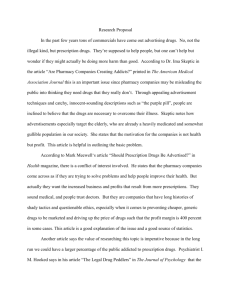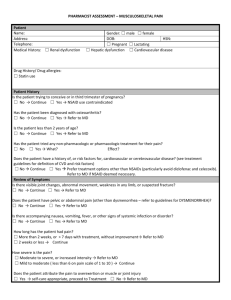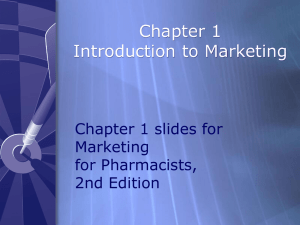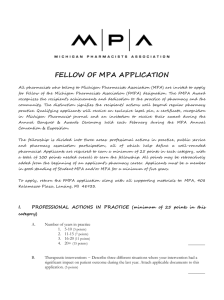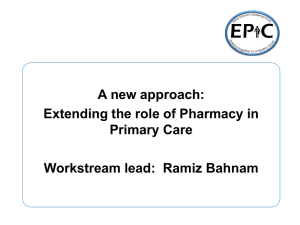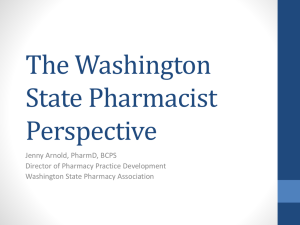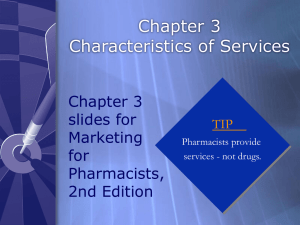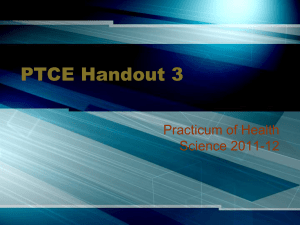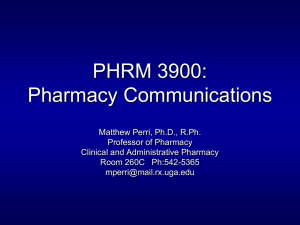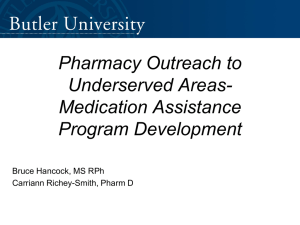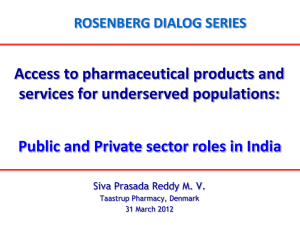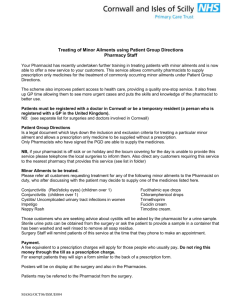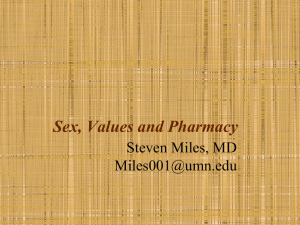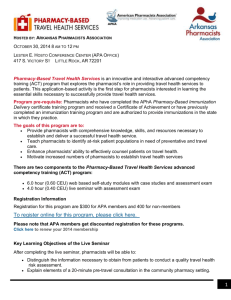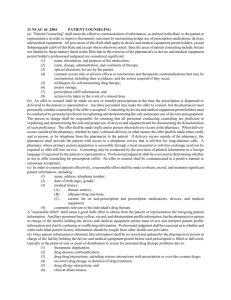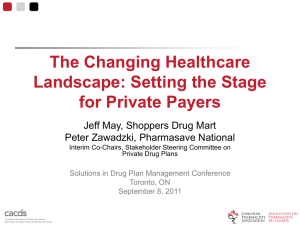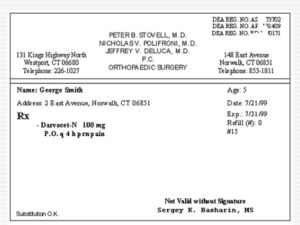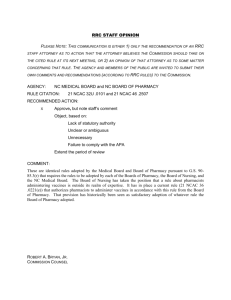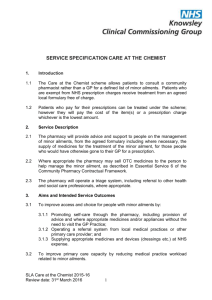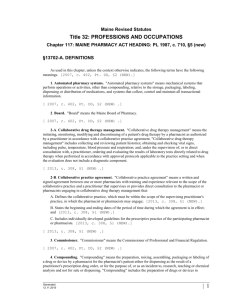2011 Marketing Lecture
advertisement
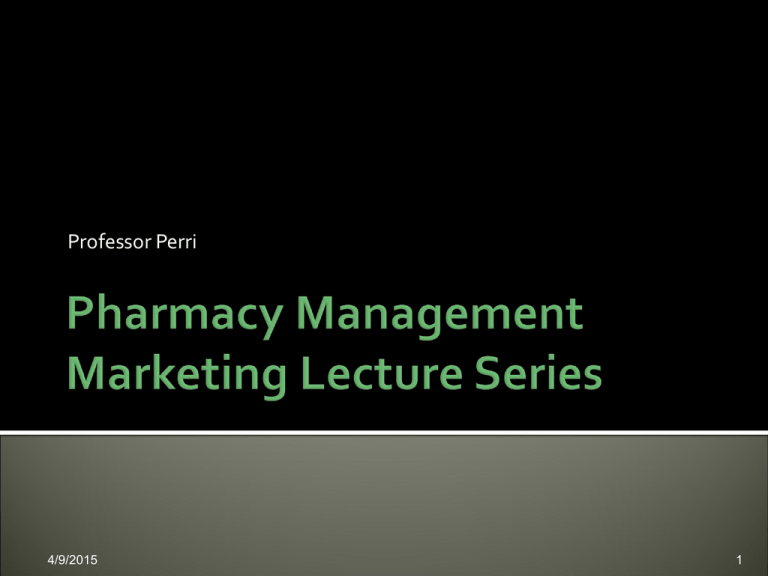
Professor Perri 4/9/2015 1 4/9/2015 A salesperson? Advertising? Public relations? Buying an ad in the yellow pages? 2 Marketing: the process of exchanging something of value, usually money, for something you “need” or “want” Key concepts: 4/9/2015 Needs Wants and demand Value Satisfaction 3 4/9/2015 4 In performing activities directed at meeting people’s needs – pharmacists play the role of a personal marketer: Dispensing, OTC counseling, counseling patients, teaching pharmacy students, performing a pharmacotherapy review 4/9/2015 But, there is a mindset - “I am a health care professional, not a fast talking used car salesman.” 5 Should HC be advertised? ▪ How do you know if you need surgery? You certainly don’t learn this from an ad. What about needing Nexium? Can you, should you, learn this from an ad? Credibility and experience ▪ Do YOU want to be the FIRST your surgeon operates on? Many patients have limited ability to differentiate services and products ▪ Perhaps because we don’t make the patient’s experience remarkable? Hard to maintain quality encounter to encounter ▪ Some patient experiences go better than others. 4/9/2015 6 People and groups other than pharmacists are in control of pharmacy. ▪ PBMs, Corporations, Government We tend to focus too much on the prescription and not on the “service” component (counseling) that is of most value to the patient. Balancing clinical and business roles. “The most trusted professional…..” ▪ While this is true, people must expect very little. 4/9/2015 7 And the pharmacist shortage may be nearly over… Changes in staffing and customer service New technology and services Transient communities 1 in 5 customers move every year College town? Patient perceptions I just love… [insert your favorite doctor, pharmacist, pharmacy] …and there is someone whose experience is quite different. Should pharmacists be able to influence this perception….? 4/9/2015 8 Advertising = providing information Pharmacists = provide information So, ▪ It should be apparent we need to get the word out. ▪ Recognize there will be differences in the way customers perceive advertising information. ▪ Need to pay close attention to our “marketing philosophy.” 4/9/2015 9 4/9/2015 10 4/9/2015 11 TOMA, but for whom? 4/9/2015 12 Markets, market segments and target markets, more on this in a couple minutes, but first: 4/9/2015 13 4/9/2015 14 Product Orientation What do you have to sell – then sell it. 4/9/2015 Marketing Orientation Find out what people need – then create products to satisfy these needs. 15 COMPANY PRODUCT ORIENTED MARKET ORIENTED AOL WE PROVIDE ONLINE SERVICES WE CREATE CUSTOMER CONNECTIVITY, ANYTIME ANYWHERE HOME DEPOT WE SELL TOOLS AND HOME REPAIR EQUIP WE PROVIDE ADVICE AND SOLUTIONS NIKE WE SELL SHOES WE HELP PEOPLE EXPERIENCE COMPETITION, WINNING REVLON WE SELL COSMETICS WE SELL MEMORIES, HOPES, DREAMS WAL MART WE RUN DISCOUNT STORES WE DELIVER LOW PRICES EVERYDAY GREYHOUND BUS WE MOVE PEOPLE FROM POINT A TO B WE BRING PEOPLE TOGETHER B&O RAILROAD WE MOVE MATERIALS EVEN WARREN BUFFET COULDN’T HELP THE RAILS! 4/9/2015 16 4/9/2015 17 Develop marketing plan This is a business plan that maps out an overall strategy on how we will reach and meet our customers needs, better than the competition. Basically, how we will become “Remarkable” Bottom line, must determine how to manipulate the 4 P’s and 4 I’s to maximize customer satisfaction. 4/9/2015 18 Strengths Weaknesses Opportunities Threats Resource Analysis Set Marketing Goals Develop Marketing Strategy Evaluation Implementation The Marketing Process 4/9/2015 19 Market summary Define your product and set marketing goals Identify and select target markets Establish competitive advantages Design and implement marketing strategies Evaluate success, revise and adjust plans 4/9/2015 20 Setting the stage: ▪ ▪ ▪ ▪ ▪ Strengths and weaknesses Opportunities and threats Legal considerations Social, ethical, political issues New technology What is it that you think customers want the most? Is there anything about your idea, practice site, pharmacy that is remarkable? 4/9/2015 21 Market: past, present, & future Review changes in economic, political, legal issues, market share of competitors, other players, market shifts, costs, pricing, SWOT, etc. Number of customers Early Adopters/ Pioneers Mass Market/ Followers End of Life Time 4/9/2015 22 The competitive landscape -SWOT Provide an overview of product competitors, their strengths and weaknesses Position each competitor’s product against new product 4/9/2015 Your Practice STMH Price D C Performance 23 4/9/2015 24 Individual’s Personal Characteristics Situational Factors Customer Satisfaction Product Quality Price Service Quality Factors Affecting Customer Satisfaction: Does this product/service make them happy and solve their problems? 4/9/2015 25 Describe product/service being marketed What exactly is our product? ▪ Think about this: When you go to buy a hair dryer – what are you really buying? Better looking hair, not a heat gun. ▪ What are you buying when you purchase a prescription? Determine the objectives we wish to reach Number of patients per month? Dollars of revenue? Some measure of patient satisfaction, improved outcomes, quality of life? 4/9/2015 26 4/9/2015 27 A process of: Identifying customer needs Figuring out just who your customers are What do they have in common How can you meet these customers’ needs Assessing and comparing various customer groups to see who you want to “target” Though Question: ▪ “You can’t be all things to all people, or can you?” 4/9/2015 28 Market All those who might need pharmacy care. Segment Groups with similarities Demographics Psychographics Lifestyle Pediatric, diabetes, HRT, gerontology, ambulatory care, lipids, asthma, allergy Target Market Segment identified on which you wish to focus your marketing efforts. 4/9/2015 29 4/9/2015 Homogeneous Group with similar needs, wants and demand Accessible Can be reached with available advertising Durable Will continue to be profitable in the future Measurable You can learn about needs, tastes and preferences easily Substantial Is a large enough group to justify entry into the market. 30 Who is the target market for your immunization program? Travelers? Yearly flu-shots? Child & adolescents? ▪ ▪ ▪ ▪ ▪ 4/9/2015 Homogeneous? Accessible? Durable? Measureable? Substantial? 31 HCTZ vs. Geodon® 4/9/2015 32 The 4 P’s of product marketing Price ▪ level, value, convenience Place ▪ Convenience, hours, delivery, charge, decor Product ▪ Assortment, advice, satisfaction Promotion ▪ Product v. image oriented The 4 I’s of service marketing Intangible ▪ It is a perception Inseparable ▪ Tied to the bottle of pills Not Inventory ▪ How many counseling sessions do you have in you today? Individualized ▪ Each patient encounter is going to be different – the patient and you Philip Kotler, Marketing Professional Services 4/9/2015 33 Wholesale and retail issues 3rd Party Reimbursement Prices AWP, WAC, MAC, FUL, Cost-to-dispense, Professional fee, delivery fee, administrative fee, generic incentive, acquisition cost? Cash price Competition Walmart $4 Insurance co-pay’s and price Credit Visa, MC, Amex, Discover, in house credit accounts, discount cards 4/9/2015 34 Convenient location Customer access to the pharmacy / pharmacist Is on-line a consideration? Is this even a “place” issue? What about phones? (i.e., CVS Rapid Refill) Attractiveness of the: External store Location Layout inside the store Delivery (and maybe even mail delivery) 4/9/2015 35 Possible Pharmacy Care Clinic sites examined in 2001 Sketchy $$$ 4/9/2015 36 4/9/2015 37 1500 square feet Lab Business office Waiting area Lavatory Storage 3 patient exam / education rooms 4/9/2015 38 4/9/2015 39 What is our product? How do customers see it? Is “product” the same for everyone? Think about needs, wants and demand, how do these fit with prescriptions? 4/9/2015 40 Tangible “Bottle of pills” Coke Cars Cosmetics Advertising Teaching Patient Counseling Less Tangible 4/9/2015 41 Some experts claim you don’t have a fixed amount of “service” on the shelf in the pharmacy. However, many pharmacists disagree and think there is a limit to how many patients you can counsel in a day of work. It has been suggested to limit pharmacist’s work day to about 120-140 Rx’es working with a single tech. http://www.usalaw.com/articles/pharmacist-pharmacy-errors/pharmacistworkload---north-carolina-board-of-pharmacy.php But it is true there is no fixed limit, and technically, they can’t be counted. 4/9/2015 42 4/9/2015 43 Advertising, public relations, personal selling and in-store promotions. 4/9/2015 44 Sell more existing product/services to current customers Market penetration Sell existing products to new customers Market expansion Sell new products to existing customers Development Sell new products to new customers Diversification The strategy you choose, will impact the decisions you make with regard to the 4P’s and the 4 I’s 4/9/2015 45 Strategy & execution Overview of strategy ▪ Utilize existing patient base for office based appointments ▪ Advertise to community for health screening activities Overview of media & timing ▪ Newspaper, radio and cable TV ads Overview of ad spending ▪ $10K for 30-60 day campaign, with LIMITED newspaper ads (30 spots on cable = $3000, 1 small ad in newspaper could cost ½ of that!) 4/9/2015 46 Strategy & execution PR strategies PR plan highlights Have backup PR plan including editorial calendars, speaking engagements, conference schedules, etc. 4/9/2015 47 Direct marketing Sales calls to other physicians / groups Third-party marketing Co-marketing arrangements with other companies ▪ US Wellness ▪ Novartis ▪ State DHR 4/9/2015 48 Social Media Is not the traditional unidirectional broadcast paradigm that most marketers are used to. Use of social media means you must understand how to listen to and engage with users, continually optimize and refine your message, and rapidly adapt to changing technical and legal realities. 4/9/2015 49 Social Media Listen ▪ Twitter, Facebook ▪ Keyword searches to identify blogs, wiki, information about the competition, industry, etc. ▪ Both positive and negative: Actress, Jenny McCarthy claimed her child became autistic as a result of a vaccination. True? False? Does it matter? 4/9/2015 50 Engage ▪ You want to make sure you control your content. ▪ Monitor rogue content. ▪ Discussion groups… 4/9/2015 51 Engage: Tools like Facebook, Twitter and YouTube provide great platforms to listen and engage people in discussions. Unlike traditional broadcast advertising, social media allows marketers to measure the audience, and in some cases, the actual conversions that result from a campaign. Interactions on Facebook and other channels often are accompanied by rich and detailed user profiles. Marketers have visibility into the demographics, interests, and histories of individual users on those channels. 4/9/2015 52 Depends on the product/service balance For any given product, there will be a unique product/service mix and decisions need to be tailored to each situation. Consider how decisions will be different for each of the following: 4/9/2015 An OTC bottle of Geritol® The 33rd refill of a patients HCTZ A new prescription for Lipitor® A new prescription for Lortab® First time oral contraceptive prescription 53 4/9/2015 54 4/9/2015 The best product mix decisions are the ones that meets our target market’s needs. 55 Lots of questions to ask: ▪ When do we start? ▪ Promotion budget ▪ Detailed budget information ▪ Will billing strategy be in place? Phase 1 Phase 2 Phase 3 Jan 4/9/2015 Feb Mar Apr May Jun July Sep Oct Nov Dec 56 4/9/2015 57 First year, second year, etc. goals Numbers are good. Specific, measurable and realistic? Economic measures of success/failure Requirements for success Personal satisfaction? Financial considerations? Patient health, contribution to the community and society? 4/9/2015 58 18-month schedule highlights Timing Isolate timing dependencies critical to success Task 1 Task 2 Milestone Task 3 Task 4 Jan 4/9/2015 Feb Mar Apr May Jun July Sep Oct Nov Dec 59 Hope you have a great spring break! 4/9/2015 60

